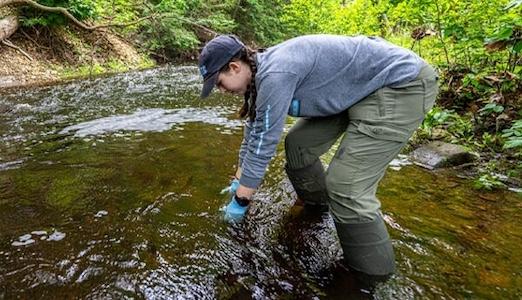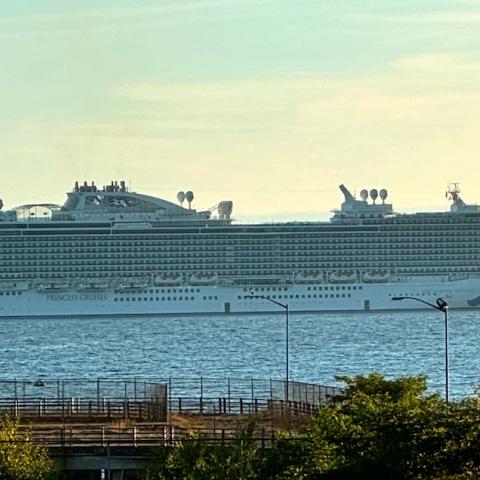
Grace Johnson collects water samples from a stream on Mount Desert Island in July 2023.
Microplastic fibers, those tiny fuzzy filaments that have been spewed across the world, are swirling in the waters of Acadia National Park, according to a study from the University of Maine.
According to researchers, there are an estimated 400 billion microplastic fibers on the surface of Frenchman Bay and several connected rivers and estuaries where freshwater from rivers meet the Atlantic. The watershed contains an average of 1.8 fibers per liter of water.
“Imagine the 32-ounce water bottle you use every day. If you were to fill your water bottle with water from Frenchman Bay, you would find about two microplastics. Now imagine how many water bottles would fit in the massive volume of Frenchman Bay; that is a lot of microplastics,” said Grace Johnson, lead author and master’s student in civil and environmental engineering.
Johnson collaborated with other UMaine students and faculty and researchers from the University of Notre Dame and Valparaiso University, both in Indiana. Their research was published in Environmental Engineering Science.
Microplastics are smaller than five millimeters in length, tiny enough for humans and animals to ingest with ease, but trillions of them have been found in rivers, lakes and oceans worldwide. They are the result of the breakdown of plastic bottles and bags, fleece jackets, and even buoys that point to lobster traps, vessel anchors, and channels.
Early this year the Traveler reported on microplastics turning up in the excrement of Galapagos penguins. Back in 2020, researchers detected microplastics in a number of Western national parks.
Microplastics can impair digestion and reproduction in animals, and some of their additives are associated with endocrine disruption and cancer in humans, according to the U.S. Geological Survey. They can also absorb and transport other harmful toxicants that pollute waterways, including a group of chemicals known as PFAS.
The University of Maine researchers conducted two water sampling campaigns for the study in 2022 and 2023. Using glass mason jars, they collected 129 samples in the bay, river and estuaries off the side of a boat in 17 weeks. Using microscopes, the fibers were pinpointed in the samples and their properties were analyzed by measuring their light signatures — the color and wavelengths of the light that cells reflect or absorb.
Concentrations of microplastics were, on average, highest in Frenchman Bay, followed by the connected rivers and then the estuaries, according to a release from the university.
“What is striking to me is that we collected water samples in the open ocean and we were still able to find one-to-two microplastic fibers in pretty much every liter we sampled,” said Onur Apul, study co-author, Johnson’s advisor and assistant professor of environmental engineering. “The quantities we are seeing in the natural environment are variable, but it is indicating that we created a new environmental domain — the ‘microplastisphere’ — during the extremely short timespan that we occupied the planet.”
The team also investigated how microplastics traveled throughout the watershed by sampling water from nine sites on Mount Desert Island, particularly within the town of Bar Harbor. In 2023, they collected water samples from the culvert at Grant Park, right across from Bubble Rock; a couple sites at Kebo Stream; and several sites at or near Cromwell Brook, including the wastewater treatment plant and a culvert for the transfer station. They sampled on clear days and during rain events, as culverts release stormwater.
The Grant Park culvert possessed the highest concentrations of microplastics by a wide margin at 15 fibers per liter, followed by the wastewater treatment plant, the transfer station and the other spots along Cromwell Brook and Kebo Stream. Average concentrations of microplastic fibers in all locations, however, were higher than those in the estuaries, rivers and Frenchman Bay.
Study findings indicate that microplastics were transported from the land through the rivers and estuaries into Frenchman Bay. According to researchers, weaker currents allow fibers to remain in the bay for longer periods. The research team recommends additional studies into contamination in the bay and surrounding watershed to support possible techniques for mitigating the spread of microplastics.
“Once the microplastics are dispersed in Frenchman Bay there is no removing them, and they pose a threat to both marine life and humans. In the bay, fish and other marine species can ingest the microplastics, and when people eat the fish, they can also ingest microplastics. Therefore, it is important as a society that we create less plastic waste capable of ending up in the ocean,” Johnson said.




 Support Essential Coverage of Essential Places
Support Essential Coverage of Essential Places






